Nine years in London, where street names are uncomplicatedly monolingual, had left me yearning for the bonus material Irish signs provide.
When out and about in Dublin, I love to pause for a moment to appreciate that I am not simply in the capital, but in the town of the ford of the hurdles (long gone), which is also situated on a black pool (also long gone). It adds colour, particularly when you are trying to cultivate a sort of returning-emigrant joy to drown out any complaints you might have about the public transport.
But even with my flawed, conversational command of the Irish language, it didn’t take much looking to find bones of contention. Observational walks around the capital, which, for all its faults, is home to a nationally unparalleled number of street signs, reveal some confusing information about the Gaelic world underlying the modern anglophone city.
Rathgar is a shape of a word that signals a Gaelic origin. But is it Ráth Garbh, the rough rath, as some signs say, or Ráth gCeárr, a better phonetic match, as others maintain? Or take Raheny: is it Ráth Éanna or Ráth Eanaigh? Is it a rath belonging to Éanna or one near a marsh? Sources, and uses, differ.
READ MORE
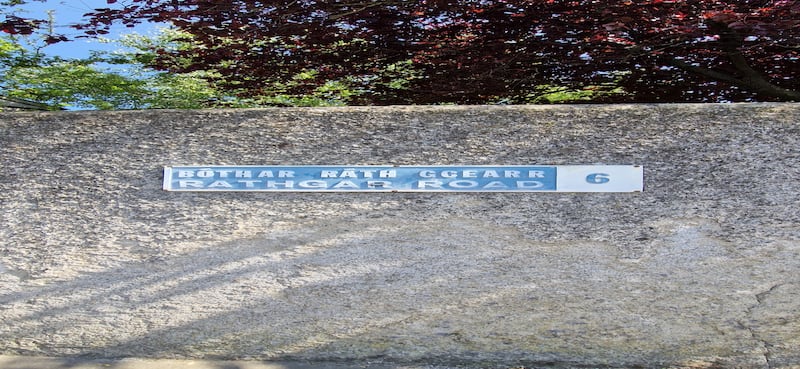
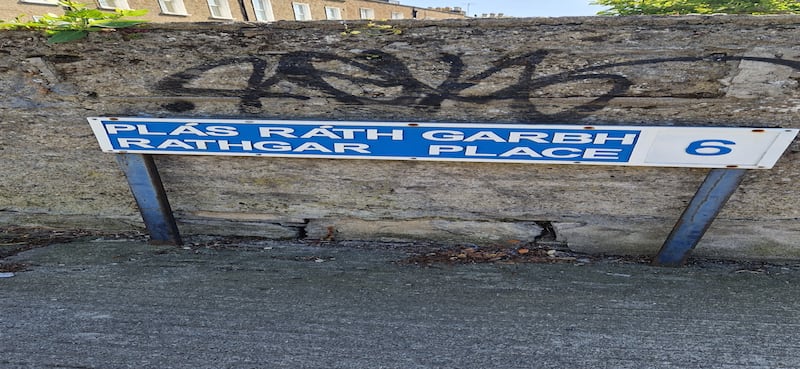
It is not uncommon either for street signs at either end of a street to disagree about the name of that street. A sign on leafy Kenilworth Road in Dublin 6, declares it to be Bóthar Cineilm, or the road of a gaelicised version of the Saxon saint after whom the original Warwickshire Kenilworth is assumed to have been named. But the adjoining park leaves it at Páirc Kenilworth.
Chatham Street, on which one might sit outside Neary’s with a pint, is Sráid Chatham, uncomplicatedly English in spite of the fact it would be pronounced very differently in Irish. Balfe Street, off it, is Sráid Balf, the sound rendered directly in Irish spelling. At the top, Sráid Ghrafton is somewhere in between, grammatically mutated but otherwise keeping the basic shape of the non-Irish-speaking grandson of Charles II after whom it was named.
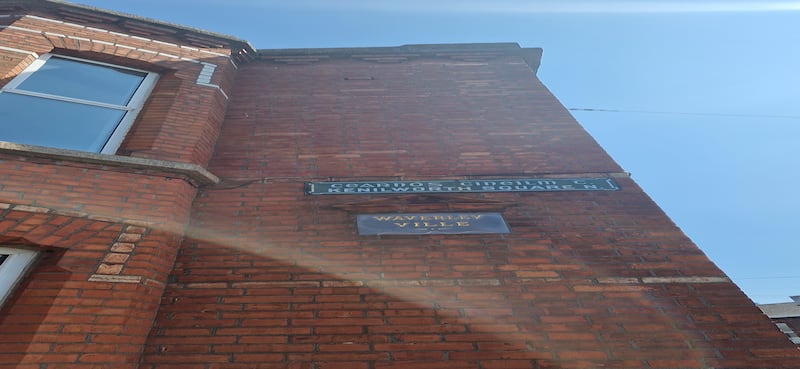
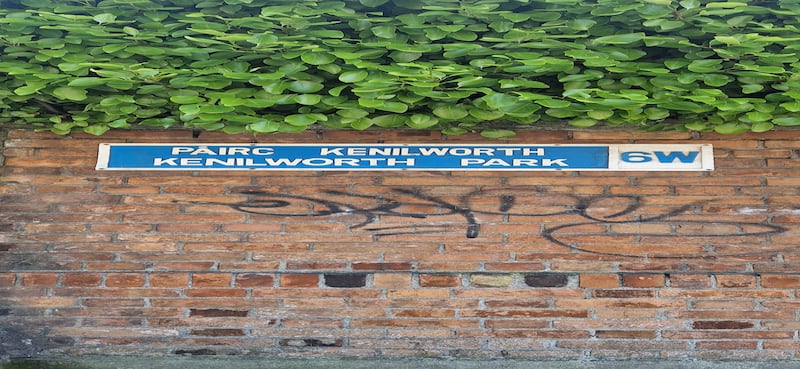
The problem, is that none of these decisions are outright wrong. They’re just decisions
The problem, of course, is that none of these decisions are outright wrong. They’re just decisions. It’s easier to translate a barely translated Ballymore back to Baile Mór than it is to come up with the an Irish way to spell Molesworth Street (Sráid Theach Laighean, by the way, dodging the problem), so it’s perhaps unsurprising that it’s hard to discern the exact system in place on city street signs riveted in place across a century.
Gaeilgeoirs do notice these things, though. Those I encountered during the reporting of this article considered the variation situation “bad” and proffered examples of their own. In 2021, Senator Lorraine Clifford-Lee even raised a specific case in the Seanad, of no more import than any other but perhaps illustrative of the dangers surrounding us for those who have eyes to see. “There is a roundabout outside Swords called the Estuary Roundabout. I noticed the Irish name on it was Timpeallán Bhóthar na Mara,” she said, “which does not translate as Estuary Roundabout.”
Against the tide of confusion stand a select group of researchers who work in a field that would probably be less contentious in a country where the official language aligned more closely with the common language. There’s the likes of Brian Ó Raghallaigh, the lead investigator of Dublin City University’s Gaois research group, which runs logainm.ie, a modern and user-friendly database of the placenames of Ireland in Irish and English.
[ Have you been to ‘Queen Maeve’s Vulva’? Ireland’s oddest placenamesOpens in new window ]
He and his colleagues are engaged actively in the clean-up. Using logainm.ie, Dr Ó Raghallaigh says, will provide “exactly one Irish and one English official/standardised name for each place/division/street”, making it the theoretical truth. That information then filters in various ways to Eircode, An Post, Google Maps, Apple Maps and elsewhere, becoming the practical fact everywhere online. Then, as local authorities replace signs, the standardised forms will appear there too.
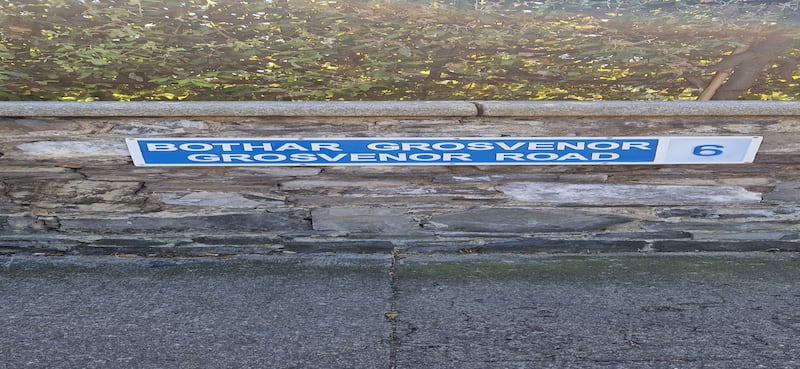
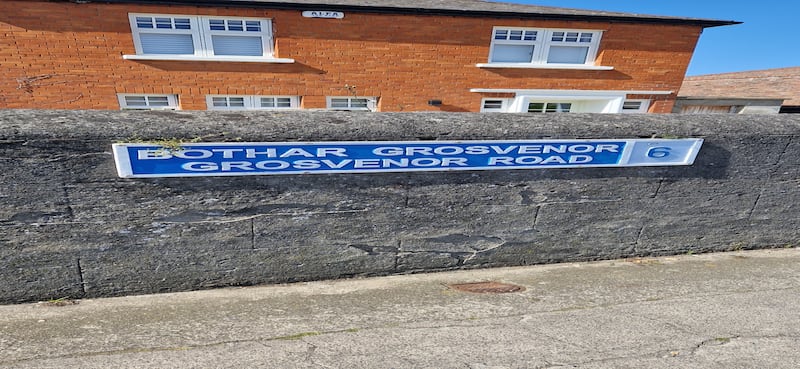

That’s how it works in theory, but somehow the years pass and the inconsistencies – in the physical realm, at least – remain. One unlikely foe is the very beauty of the older signs. The Irish on some of them clangs badly compared with current official translations, but, with their Gaelic lettering beaten into iron, they appeal to local residents more than a generic modern version ever could.
“Much of the old signage incorporates heritage colouring, typeface, orthography, spelling, etc, that is worth preserving, even if they also include mistranslations or mistakes,” says Dr Ó Raghallaigh. “People can be quite attached to the signs and indeed sometimes the older non-standard or erroneous names. This is something that has to be handled and documented carefully.”
Whatever caused the loss of our culture, it wasn’t the Ordnance Survey
— Dr Conchubar Ó Crualaoich, chief placenames officer at the Placenames Branch
The footsoldiers in the fight are the officers of the Placenames Branch of the Department of Culture and Gaeltacht, situated amid leather-bound tomes and historical maps in an otherwise nondescript office building on Lombard Street in Dublin.
The branch is responsible, in the wake of the 2003 Official Languages Act, for finding the proper Irish forms of Ireland’s administrative divisions down to townland level. They research, sometimes going as far as consulting ancient deeds and church records, collecting local pronunciations and interrogating the 19th-century decisions that have shaped many of the English forms of Irish places that must now be rendered in their correct original form.
Dr Conchubhar Ó Crualaoich, chief placenames officer at the Placenames Branch, is defensive of that original Ordnance Survey project, contributed to by native speakers such as John O’Donovan and dramatised (though it “wasn’t really like that”) in Brian Friel’s play Translations. “Whatever caused the loss of our culture, it wasn’t the Ordnance Survey,” he says.
The research goes to the placenames committee, which is in a process of renewal, a new crew of pro-bono experts being recruited, which will either argue back or accept the name. If accepted, there is a draft placenames order issued for feedback, and finally a non-draft placenames order, “fixing” the names officially. They’re well in progress, with nine done, nine in draft form and the remainder under way.
[ Why does the devil’s mother have testicles?Opens in new window ]
This process does not, however, apply to street signs. These are the responsibility of councils, which vary widely in the standard of their work.
“The main issue with Irish-language streetnames is that legally they are the responsibility of the respective local authority, and most local authorities do not keep authoritative lists/schedules/databases of street/road names and often they do not have the expertise to deal with the Irish names anyway,” says Ó Raghallaigh. “As a result, name plates are often erroneous/inconsistent, especially older ones.”
It’s also a source of frustration for Dr Ó Crualaoich, who notes inconsistencies he sees on his travels. “A hundred years after the establishment of the State, we still have different names on different ends of the same street,” he says.
Dr Ó Crualaoich recounts a recent letter highlighting this on New Church Street in Dublin’s north inner city, which declares itself both Sráid an Teampaill Nua and Sráid Nua an Teampaill, a subtle distinction that is nonetheless sufficiently annoying to provoke correspondence from the public. To this, he says with some frustration, there is already a clear answer: it’s Sráid an Teampaill Nua. Officially. On logainm.ie. No matter what the signs say.
So how does a punter go about getting it changed? Not by contacting the Placenames Branch, who might tell you the right answer, but can’t get it bolted to the corner of your street. It’s the council’s job – and while producing change there may seem like a Kafkaesque project, there is a champion available to lead the charge.
“The best way to get it changed is to bring it up with the Language Commissioner [An Coimisinéir Teanga],” says Dr Ó Crualaoich. “Contact your local authority, and, if that doesn’t work, go to the Language Commissioner. Take pictures of the signs. If it’s a clearly incorrect form, the council will have to change it.”
In a sense, competing name styles reflects the multiplicity of views of Ireland that compete beneath the anglophone surface. One vision might see the English-speaking world as a false imposition, and the job of the translator that of a monolingual Gael tasked with making phonetic sense of the incomprehensible blather slapped on signs. What if we did it back to them, the translator of 20th-century Ireland might think as he scratches Sráid Líosain for Leeson Street on his index card.
But another might see a process of historical recovery, consulting all available documents to find out what an area might have been called when ″all this was fields”. The Post-Seanchas, a work by Ranelagh linguist Seosamh Laoide, proposed names of this sort for places, particularly in Dublin. The work recovered from medieval English documents a place somewhere between Donnybrook and St Stephen’s Green along the lines of Kylmagergan or Kilmerecaregan, dubbing it at a guess Cill Mhuire Carraigín, the Church of Our Lady of the Little Rock. Sráid Chill Mhuire was Leeson Street’s first official Irish name, later altered on another scholar’s recognisance to Sráid Choill Mhac Cargáin, the Street of the Wood of Mac Cargáin, again using guesswork.
Another translator might be studious but stoic: if it has a name, why change it? If the name is obviously English, why pretend? This view would give us Sráid Leeson, from the Leesons, a prominent Anglo-Irish brewing and governing dynasty after which it is actually named.
Another, a pragmatist, might check what’s on the sign already and leave it unless it’s truly egregious, bringing us back to Sráid Líosain (in most cases).
Farther afield, in Swansea, a sign read “No entry for heavy goods vehicles. Residential site only” which was given in Welsh as “I am not in the office at the moment. Please send any work to be translated”
The guidelines for street signs now, for what it’s worth, recommend English proper names stay in English and the rest be translated without undue romance or fervent efforts to regaelicise the country in the medium of italic typeface on metal. They also hold, however, that it would be “far better” to retain certain names created under previous systems, owing to a “certain historicity” that inheres in them. Which leaves us in a somewhat muddled holding pattern, one that has been in place since those guidelines were issued in 1992. Dr Ó Crualaoich is hopeful that updated guidelines might be addressed by the soon-to-be-appointed placenames committee.
Sneering on the sidelines on this scholarly debate, a cynic might claim that none of this matters, that the Irish names for most places are a piece of cultural colour at best, and a costly distraction at worst. We can infer that there are some who hold this view, whether in rural towns concerned to have large and legible English to attract passing American dollars or among urbanites who cannot picture a situation where you would need a historically accurate way to say what everyone simply calls Green Street. They simply don’t care, and they give us outrageous mistranslations. There was the period in 2012 when Cork’s English Market was called Béarla sa Mhargadh, meaning “English Language in the Market”, or, farther afield, the extreme case of the Swansea sign reading “No entry for heavy goods vehicles. Residential site only” which was given in Welsh as “I am not in the office at the moment. Please send any work to be translated.”
While English is the everyday language of Ireland, and while views of how we feel about that fail to reach consensus, looking at street signs is going to be confusing. It’s hard to know where you are if you don’t really know where you are.
















